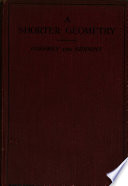 | Charles Godfrey, Arthur Warry Siddons - Geometry - 1903 - 384 pages
...different numbers instead of 8 and 13. The above exercises lead up to the fact that "In a right-angled triangle the square described on the hypotenuse is equal to the sum of the squares on the other two sides." This famous theorem was discovered by Pythagoras (BC 570 —... | |
 | International Correspondence Schools - Arithmetic - 1904 - 656 pages
...values for the sides in (1), AD : 8 = 24 : 18 ; whence, AD = — £— = 10*. Ans. 18 58. In any right triangle, the square described on the hypotenuse is equal to the sum of the squares described upon the other two sides. If ABC, Fig. 28, is a right triangle right-angled... | |
 | Education - 1911 - 1334 pages
...Parallelograms on equal bases, and between the same parallels, are equal in area. 4. In a right-angled triangle the square described on the hypotenuse is equal to the sum of the squares described on the other two sides. 6. If from a point O within a triangle A, B, C, perpendiculars... | |
 | United States. Bureau of Naval Personnel - Arithmetic - 1913 - 144 pages
...30° does the other acute angle equal? Solution.— 90° - 30° = 60°— Answer. 39. In any right triangle, the square described on the hypotenuse is equal to the sum of the squares described on the other two sides. If ABC, figure 23, is a right triangle, right angled... | |
 | Charles Ernest Chadsey - 1914 - 274 pages
...number multiplied by itself, or used tw1ce as a factor, is said to be "squared." In a right-angled triangle, the square described on the hypotenuse is equal to the sum of the squares described on the other two sides.* 1. In the figure, the hypotenuse represents the number... | |
 | Marshall Clagett - History - 2001 - 246 pages
...triangle on a given straight line." The second kind are theorems — eg (I, 47), "in any rightangled triangle, the square described on the hypotenuse is equal to the sum of the squares on the other two sides." The organization within propositions was itself very formal... | |
 | Laura Knight-Jadczyk - Antiquities - 2005 - 829 pages
...Pythagoras, erroneously attributed to Euclid. The Forty-seventh Theorem is stated thus: In a right-angled triangle the square described on the hypotenuse is equal to the sum of the squares described on the other two sides. 184 Everyone who has attended public school and paid... | |
 | 352 pages
...BC = ...cm., sq. on BC = ...sq. cm. The above exercises lead up to the fact that "In a right-angled triangle the square described on the hypotenuse is equal to the sum of the squares on the other two sides." This famous theorem was discovered by Pythagoras (BC 570 —... | |
 | James McMahon - 2018 - 244 pages
...different numbers instead of 8 and 13. The above exercises lead up to the fact that "In a right-angled triangle the square described on the hypotenuse is equal to the sum of the squares on the other two sides." This famous theorem was discovered by Pythagoras (BC 570 —... | |
 | 480 pages
...BC=...sq. cm. The above exercises lead up to the Theorem of Pythagoras. THEOREM 29. In a right-angled triangle the square described on the hypotenuse is equal to the sum of the squares on the other two sides. This famous theorem was discovered by Pythagoras, a Greek who... | |
| |